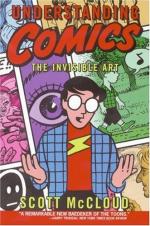
|
| Name: _________________________ | Period: ___________________ |
This quiz consists of 5 multiple choice and 5 short answer questions through Chapter 2, The Vocabulary of Comics.
Multiple Choice Questions
1. Due to the negative connotation of the word "comics," many comics artists have preferred to be known as ________________________.
(a) Cartoonists
(b) Illustrators
(c) Commercial artists
(d) All of the above
2. What additional early examples of comics does the author mention but NOT cover?
(a) Trajan's column
(b) All of the above
(c) Japanese scrolls
(d) Greek painting
3. The author believes that comics is an art form similar to which of the following?
(a) Music
(b) Theatre
(c) Written word
(d) All of the above
4. When McCloud refers to the word icon, to what is he referring?
(a) Any image used to represent a person, place, thing or idea
(b) A representation of some sacred personage, as Christ or a saint or angel, painted usually on a wood surface and venerated itself as sacred
(c) A picture or symbol that appears on a monitor and is used to represent a command, as a file drawer to represent filing
(d) One who is the object of great attention and devotion; an idol
5. Who does the author say is the father of modern comics?
(a) Rudolphe Töpffer
(b) Scott McCloud
(c) Stan Lee
(d) Will Eisner
Short Answer Questions
1. Using the pictorial vocabulary pyramid, Mary Fleener's style is NOT typically comprised of ________.
2. Who was the woodcut artist known for his silent "Woodcut Novels" of fables?
3. Which of the following icons are fluid and variable in how realistic they are?
4. Who is the author of the book?
5. Herge's Tintin was characterized by very iconic characters with unusually realistic backgrounds. This style is called _______.
|
This section contains 268 words (approx. 1 page at 300 words per page) |

|




